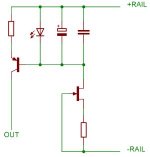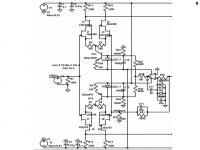Current Source <- how to optimize?
To the audio gurus:
I'm just learning audio circuit design. For the input stage of a power amplifier, I need a constant current source. I know I can use a simple resistor, but this will not be optimal I guess.
The picture below shows the simplest possible approach. How can this be improved / optimized (only regarding sound)?
To the audio gurus:
I'm just learning audio circuit design. For the input stage of a power amplifier, I need a constant current source. I know I can use a simple resistor, but this will not be optimal I guess.
The picture below shows the simplest possible approach. How can this be improved / optimized (only regarding sound)?
Attachments
Hi EE,
the way you set up the CS looks OK. Adding a cap parallel to the zener diode might reduce noise. If you want the CS even more stable you can add a cascoding transistor. But I cannot tell you if this really would improve the sonic quality.
Regards
KlausB
the way you set up the CS looks OK. Adding a cap parallel to the zener diode might reduce noise. If you want the CS even more stable you can add a cascoding transistor. But I cannot tell you if this really would improve the sonic quality.
Regards
KlausB
I prefer LEDs as voltage references in a CCS. Noise and temp. coeff. are better than a zener or string of "normal" diodes.
A simple current source for the reference element can be built using a FET and a resistor. If you need two current sources, one on each rail, you can of course use this for both sides.
Generally, a high hfe for T1 improves performance. A darlington might help. The 2SA1376 is a good choice, I think.
Here's the current source from my preamp which I like very much:
A simple current source for the reference element can be built using a FET and a resistor. If you need two current sources, one on each rail, you can of course use this for both sides.
Generally, a high hfe for T1 improves performance. A darlington might help. The 2SA1376 is a good choice, I think.
Here's the current source from my preamp which I like very much:
Attachments
I'm doing some research on this topic to design my first amplifier. After reading a lot it I came to the conclusion that a two transistor constant current source is the best option, for an image I refer to my website http://users.pandora.be/jef_patat/audio/input%20stage/constant%20current%20source.htm
kind regards, de jef
kind regards, de jef
OlivierD
for me it is hard to imagine more sophisticated current source than yours😉
but do them REALLY metter as far as sound quality is concerned?
for me it is hard to imagine more sophisticated current source than yours😉
but do them REALLY metter as far as sound quality is concerned?
does it REALY matter?
I'm not for sure if it makes a lot of difference, I just started designing my first amp.
It only appears to me that the current source I will use gives best results so I think it's the best choice, and beside 4 resistors one cap and two transistors is not the end of the world.
It matters slightly in psrr and cmrr so I stick to my choice.
kind regards, jef
I'm not for sure if it makes a lot of difference, I just started designing my first amp.
It only appears to me that the current source I will use gives best results so I think it's the best choice, and beside 4 resistors one cap and two transistors is not the end of the world.
It matters slightly in psrr and cmrr so I stick to my choice.
kind regards, jef
Re: Current Source <- how to optimize?
current source
current source cascode
current source cascode wilson mirror
MAT02
Use these words in different combinations when you are using www.google.com you come up with tons of info. Sorry not to be at much help right now. It's a big topic.
You can check some of my stuff but if you use these searchwordsEE said:To the audio gurus:
I'm just learning audio circuit design. For the input stage of a power amplifier, I need a constant current source. I know I can use a simple resistor, but this will not be optimal I guess.
The picture below shows the simplest possible approach. How can this be improved / optimized (only regarding sound)?
current source
current source cascode
current source cascode wilson mirror
MAT02
Use these words in different combinations when you are using www.google.com you come up with tons of info. Sorry not to be at much help right now. It's a big topic.
In the link Jaycee provided i would use number 9 with an extra diode between the base of the current generator and the cascode. I do not agree with the equation for the current though. I would say that it is rather Io=(2*Vdiode-Vbetrans)/R2
http://www.4qdtec.com/csm.html
I think ideally, that the 2 best CCS is fig4 and fig9.
But i'm curious rather about the sounds of these different solutions.
Has anyone real experiences about these solutions in practice ?
Which one is the better for the sound, if this can be sayed.
I think ideally, that the 2 best CCS is fig4 and fig9.
But i'm curious rather about the sounds of these different solutions.
Has anyone real experiences about these solutions in practice ?
Which one is the better for the sound, if this can be sayed.
Apparently the cascoded current source is one method for reducing memory distortion in the LTP. Read http://peufeu.free.fr/audio/memory for more details. Similarly a cascode VAS is a big improvement but I've never managed to add one into my symmetrical designs without either poor voltage swing or untameable oscillation.
Thx, but i knew that site, and i'am curious rather for experiences
from the real life with these solutions, the theory is not enough... 😎
from the real life with these solutions, the theory is not enough... 😎
I think they arent unpopular as current mirror.
Fig5 is the commonly used type, and the fig6 is
the less often used one, which one is ideally better.
Fig5 is the commonly used type, and the fig6 is
the less often used one, which one is ideally better.
Because of the low output impedance and temp sensitivity but they can be improved just insert emitter resistors.Ipanema said:Just curious 😕 why current mirror of circuit 5 and 6 are unpopular in audio design?
When theory is not enough...
From my experience the most pleasant sound comes from the simpler current sources, although their objective performance is worse. A simple one-transistor-circuit with a heavily filtered voltage reference is hard to beat. If you have a very clean power supply and some headroom regarding supply voltage, a single resistor might perform even better.
From my experience the most pleasant sound comes from the simpler current sources, although their objective performance is worse. A simple one-transistor-circuit with a heavily filtered voltage reference is hard to beat. If you have a very clean power supply and some headroom regarding supply voltage, a single resistor might perform even better.
I find this true. A single cheap resistor gives better sound. Why is that?When theory is not enough...
- Status
- Not open for further replies.
- Home
- Amplifiers
- Solid State
- Current Source <- how to optimize?


